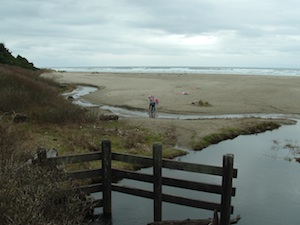
Current Status 12/07: sewage stopped, low bacteria
The Problem:
Last week our Blue Water Task Force program identified some off the chart bacteria levels at Big creek, Nye Beach and Agate Beach. With the expectation of some "first-flush" spiking, where the first major storms of the winter flush a lot of run-off and stormwater to the beaches, these results were just a little over the top compared to some of our other beaches that weekend. When we contacted the city, we learned the bacteria spiking was a clear indication of a sewage problem we're still dealing with and the beaches were posted for several days.
We've known for sometime that this area has sewage problems. It's taken the Newport Chapter nearly 10 years to address the issue and while they're thrilled plans and finances to finally fix this problem will be in motion next summer, some it seems just can't hurry up and wait enough. If you're in the latter, a little history on the issue and the plans for fixing it might help soften the bacteria blow.
A Little History:
Ten years ago, a man named Phil Barbour was testing the local Newport beaches through Surfrider and for his own conscience. Concerned for high bacteria levels found, the Newport Chapter formally established themselves and pushed the city and state to recognize this area of concern and work towards solutions. The chapter literally spent 5 years advocating and researching before the City of Newport was convinced they were not dealing with bird poop and they had real sewer issues to work on.
Amongst many other areas in the Nye and Agate beach watershed identified to work on was Big Creek lift station and sewer line. Lift stations are the small buildings you see around town that house pumps to move sewage inline to the treatment plant. In the area of Big Creek, the sewer line runs through a low point in the chain of lift stations and during peak storm flows when rainwater penetrates the sewer line, it isn't uncommon that manholes in and around Big Creek would overtop with sewage into the creek and thus out on the beach. Additionally the lift station's pumps and holding at Big Creek are not large enough to keep up with the excess flow during the rain events.
The Solutions:
The fix for this problem is complex, costs millions of dollars and are considered major capital improvement projects. Getting this on priority for the city took some time, however today, we're in a much different place than 10 years ago. The City has fully accepted the issue, made the repair and financing projects a priority, and by next winter after the upgrades, we may never have to see another sewer overflow in this area again.
You can check out those capital improvement plans here
Tim Gross, director of public works states, "I want to assure you that the City is not sitting on our hands regarding the wastewater overflows in Agate Beach, and also the fecal/ecoli counts in the Nye Beach storm sewer outfall. We have a plan and the initial financing in place, and I think you will see a lot of progress over the next year. The project we are doing in Big Creek right now will effectively deal with all overflows east of Hwy 101. The Big Creek lift station improvements will deal with the overflows on the west side."
Moving Forward:
This is why beach monitoring programs are important. When someone tells me that we're just "monitoring the decline", I point to this story. When caring and constructive activists engage, it doesn't stop at just monitoring, it stops at protecting beaches and solving the issue. Sometimes that takes 10 years of local politics, but this story is proof that it happens. With the EPA's funding of state monitoring programs in jeopardy, it will be up to volunteers and concerned citizens to keep a watchful eye on our beaches, advocate for solutions and develop relationships with our local decision makers.

